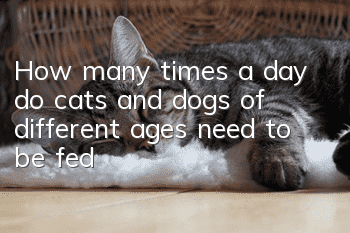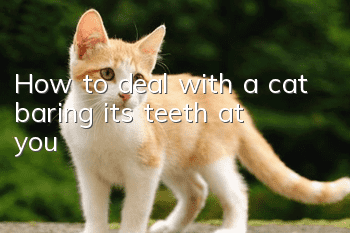How many times a day do cats and dogs of different ages need to be fed?

① Highly nutritious prescription food for dogs and cats (a/d). This food is mostly in the form of paste, packaged as toothpaste or in large syringes or cans for feeding to sick animals. Food contains high-quality protein, fat and vitamins, etc., which help the body enhance immunity and disease resistance, as well as the recovery of animals after illness. It is used in anorexia, weakness and cachexia caused by various diseases, as well as in the recovery stage after surgery and postpartum. Application should be discontinued once the body returns to normal. Severe gastrointestinal diseases are generally contraindicated. ② Prescription food for dogs and cats with urinary stones. According to statistics from the University of Minnesota Animal Hospital in the United States, there are 6 types of canine urinary stones: magnesium ammonium phosphate (struvite) stones accounting for 57%; oxalate stones accounting for 9%; urate stones accounting for 5%; and silicate stones. Less than 2%; cystine stones less than 2%; ① Mixed stones account for 5%. Cat urinary stones are mostly magnesium ammonium phosphate. There are three types of prescription foods for urinary stones in dogs and only one in cats.
a. Prescription food for dogs to prevent magnesium ammonium phosphate urinary stones (c/d): This food contains less protein, magnesium, phosphorus and sodium, and can make urine acidic after eating. Mainly used to prevent the formation of magnesium ammonium phosphate urinary stones in dogs. It is prohibited to feed this food to dogs with non-magnesium ammonium phosphate urinary stones and use it in combination with urinary acidifiers. b. Prescription food for dogs and cats to treat and prevent magnesium ammonium phosphate urinary stones (s/d): This food contains less protein, magnesium, and phosphorus, but more sodium. It can make animals drink more water and urinate more. Can make urine acidic after eating. Used to dissolve magnesium ammonium phosphate urinary stones and prevent their formation. It is prohibited to use this food to feed puppies and cats, breed female dogs and cats, and combine it with uric acidifiers. It cannot be used for heart disease, liver failure, ascites, kidney disease, edema and non-magnesium ammonium phosphate urinary stones. C. Prescription food for kynurenate, oxalate and cystine urinary stones (u/d): This food contains protein, nucleic acid, phosphorus, magnesium, calcium and less. It can turn urine into alkaline after eating. sex. It is mainly used for the treatment and prevention of urate, oxalate and cystine urinary stones, and can also be used for progressive renal failure and liver copper poisoning. Do not feed this food to dogs suffering from magnesium ammonium phosphate urinary stones.
③ Prescription food for dogs and cats to prevent and treat food allergies (d/d). This food is mainly used to prevent and treat itchy or wet skin, allergic diarrhea (even bloody) or vomiting in dogs and cats caused by eating allergic foods. It is now known that a variety of foods can cause allergies in dogs and cats, including horse meat, pork, beef, soybeans, milk, eggs, chicken, fish and crustaceans, as well as various grains containing gluten. Rice is gluten-free and lamb is hypoallergenic. Prescription food for preventing and treating food allergies for dogs. Canned food is mainly composed of rice, lamb and vegetable oil; dry food is mainly composed of eggs, rice and vegetable oil. Cat food is all canned and the main ingredients are lamb and rice. ④ Respective congestive heart failure prescription foods for dogs and cats (h/d). This food contains less sodium and protein and more potassium. It is mainly used for congestive heart failure in dogs and cats, as well as hypertension, sodium and fluid retention edema caused by liver disease and kidney disease. Do not feed this food to dogs and cats with diarrhea, dehydration or electrolyte imbalance..
⑤ Prescription food for gastrointestinal diseases in dogs and cats (i/d for dogs, c/d for cats). This food is composed of low fat, low fiber and high electrolyte ingredients. It is characterized by easy digestion and absorption and high nutritional value. Mainly used for gastrointestinal diseases (gastroenteritis, diarrhea, gastrointestinal surgery, vomiting and gastric dilation, etc.), liver disease, pancreatitis, pancreatic insufficiency, etc. It is prohibited to feed patients with congestive heart failure and renal failure this food. ⑥ Respective kidney failure prescription foods for dogs and cats (k/d). This food contains less protein, phosphorus and sodium. Mainly used for canine and cat nephropathy, renal failure, progressive liver disease, congestive heart failure and renal metabolic acidosis. ⑦ High protein prescription food for dogs and cats (p/d). This food is composed of high-quality protein and high-energy nutrients. It is mainly used for dogs and cats with debilitating diseases, anemia, post-surgery, loss of appetite, cachexia, post-illness recovery period, pregnant dogs and cats with convulsions, fractures, hypoglycemia, malnutrition, etc. Trauma etc. It is prohibited to feed this food to dogs and cats with heart disease, kidney disease, liver disease and obesity.
⑧ Prescription food for dogs and cats to lose weight (r/d). This food is composed of high-fiber, low-fat and low-energy nutrients. Dogs and cats can still eat full, but the food is low in energy. Mainly used for obese adult dogs and cats as well as dogs and cats with hyperlipidemia and lymphangiectasia. It is prohibited to feed this food to dogs and cats with serious heart disease, kidney failure and liver disease. ⑨ Prescription food for dogs and cats to prevent and treat fiber-reactive diseases (w/d). This food contains more fiber and less fat and magnesium. It can make the urine acidic after eating. The energy contained in this food is higher than that of dog and cat weight loss prescription food, but lower than that of normal dog and cat food. Mainly used for fiber-reactive diseases such as diabetes, constipation, hyperlipidemia, colitis, lymphangiectasia, feline urinary syndrome and dogs and cats with a tendency to become obese. ⑩ Prescription food for feline urinary tract syndrome (c/d, s/d, w/d). This food is low in magnesium and phosphorus, but high in sodium, potassium and taurine. It can make urine acidic after eating. Mainly used for feline urinary syndrome and magnesium ammonium phosphate urinary stones. Prescription food for preventing and treating dental calculus for dogs (t/d). This food is dry. When adult dogs chew it, it can remove tartar and calculus from their teeth and reduce abnormal oral odor. Do not feed this food to dogs with severe periodontal disease.
Dogs and cats of different breeds, individuals, and ages need to be fed several times a day, and how much commercial food should be fed each time? Dog and cat food produced by different companies have instructions on the packaging, which you can refer to for implementation. Since the protein content of commercial dog food is low and no sulfonic acid is added, it cannot be fed to cats for a long time; similarly, commercial cat food cannot be fed to dogs for a long time.
- How to train a cat to sleep in its own nest?
- When cats have "princess disease" and have a temper attack, they usually have the following symptoms:
- Why is my cat so clingy all of a sudden?
- How long does it take for a cat to be put on the bed after being dewormed?
- What does it mean when a cat meows?
- At what temperature can cats survive?
- Can male cats howl?
- Will pet cats recognize their owners?
- Why do kittens have loose and bloody stools? Why do kittens have loose and bloody stools?
- Why do cats have hard breasts after weaning?



